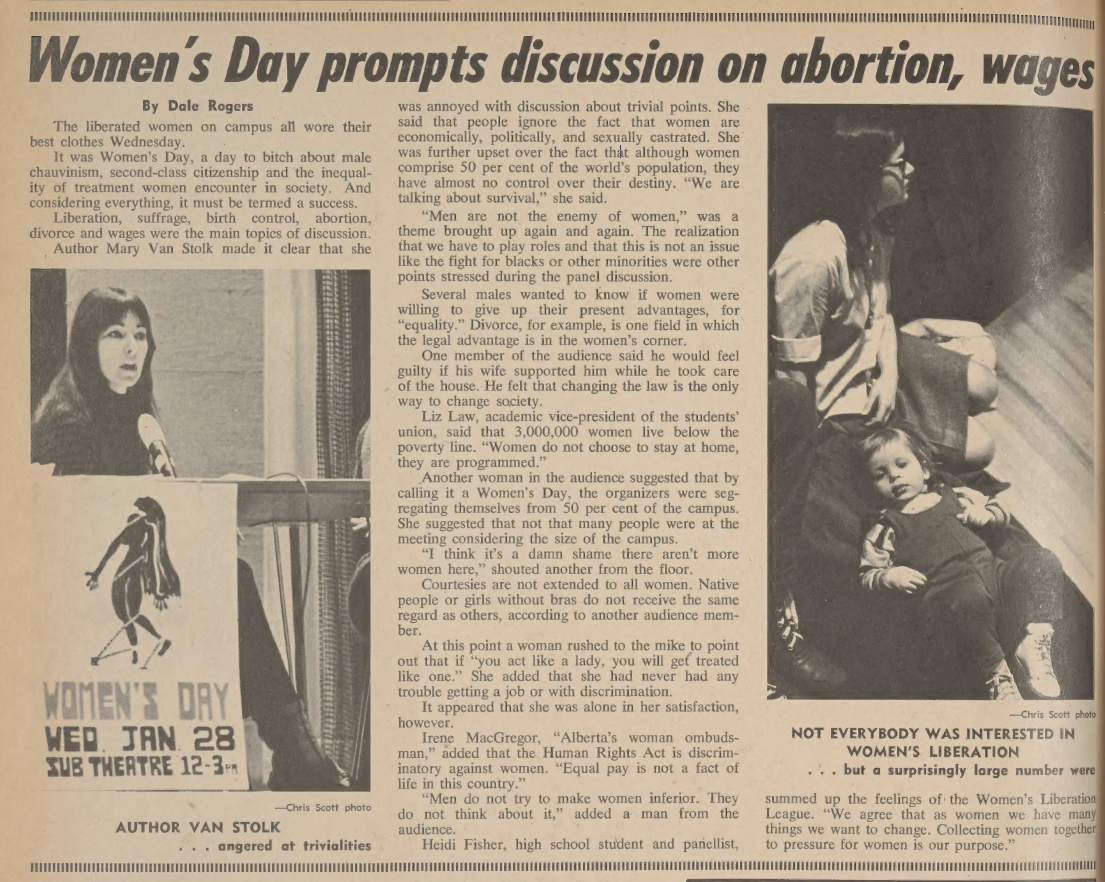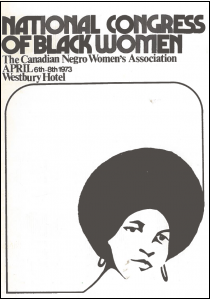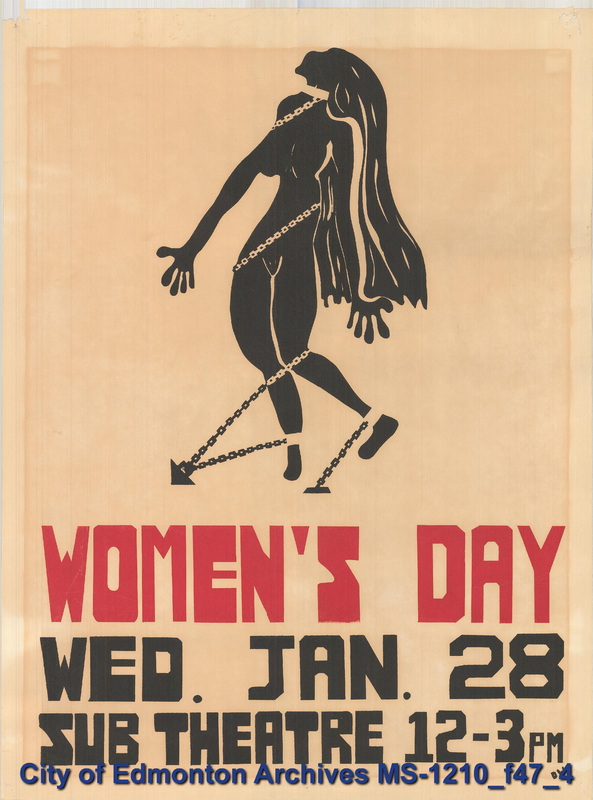Women's Day
This poster (left) was to advertise for a Women's Day event that took place on January 28, 1970, at the University of Alberta SUB Theatre. There was a panel of speakers that included female authors, university and high school students, and all kinds of women's rights advocates. The poster features the illustration of a woman bound in shackles.
The intentions behind the designs of the posters are unknown to us, but the visual aspects are interesting to interpret through a modern lens. What this poster seems to try and provoke are the ideas that women are shackled to imposed societal duties such as housework and child rearing. Looking at this poster from an intersectional feminist lens, that interpretation has value but lacks cultural depth. The figure of a woman is printed using black ink, invoking the bodies of black women. Coupled with the chains, it also depicts themes of slavery. The in-your-face red “Women’s Day” text is evocative of violence against women. In relation to modern day, the colour red is used by Indigenous women to honour and raise awareness about the multi-generational violence committed against Indigenous women (Johnson, 2020).

The student-run newspaper at the University of Alberta published a column on Women’s Day on the 29th of January of that year. The article was accompanied by a photograph of Mary Van Stolk, a speaker at the event, alongside the poster. Based on the news article, the people at this event, like the general population of the University of Alberta, appear to have been mostly white. The panel discussion at the event acknowledged the plight of women was not the same as the “fight for blacks or other minorities” (Rogers, 1970). This is contrary to what was implied in the poster, that these themes were a common struggle. While this speaker may have been attempting to say that other minorities have harder battles to fight, they also created a separation implying that women and other minorities are not the same. This silenced and made invisible women of colour who suffer the most under the white patriarchy.

At the National Congress of Black Women in Toronto in 1973, politician Rosemary Brown gave a speech on the relationship between black women and the women’s liberation movement. She said:
"…since I am a Black person, Black oppression is the only oppression with which they expect me to concern myself. But for me, not to participate in the Women’s Liberation Movement would be to deny my womanhood, and to be Black and female in a society which is both racist and sexist is to be in the unique position of having nowhere to go but up!" (Brown, 1973) Brown rejected the idea of white women’s issues being separate from black women’s oppression, black women undeniably experience both. Brown was one of the first Canadians to speak about this intersectionality of gender and race which helped to pave the way for intersectional feminist frameworks of today (Royal BC Museum, 2020).
It was also reported in the student-run newspaper that an audience member at the event said that “Native people or girls without bras do not receive the same regard as others,” while another audience member exclaimed that she had never had trouble with discrimination and all a woman needed to do is a “act like a lady” and she would be treated like one (Rogers, 1970). These comments make visible the societal expectations and disregard for non-white people during that time. While the first audience member acknowledged that there was discrimination, they unceremoniously lumped Indigenous People with anyone who did not dress “properly.” Relating someone’s entire culture with impropriety is, very mildly put, disrespectful. It speaks to the harsh judgment that Indigenous women, which can also be said of women of colour in general, have faced for hundreds of years.
White women certainly were (and still are in many cases) treated unequally to men, and they had a lot to fight against. These materials demonstrate just how different things were for all women at that time. A lot of work has been done throughout the 21st century with the Truth and Reconciliation Commission, the raising awareness of Missing and Murdered Indigenous Women and Girls (MMIWG), the Black Lives Matter movement, and many more initiatives, but the work is never complete. When comparing the history that these materials reveal and the struggles of modern-day women, it is obvious that the themes are still present in society and should continue to be critically questioned and interrogated.
References
Brown, R. (1973). National Congress of Black Women in Canada: convened by the Canadian Negro Women’s Association, Inc. https://riseuparchive.wpenginepowered.com/wp-content/uploads/cwbc-1973-speechRosemary-Brown.pdf
The Canadian Encyclopedia. (2016, September 12). Women’s movements in Canada: 1960–85. The Canadian Encyclopedia. https://www.thecanadianencyclopedia.ca/en/article/womens-movements-in-canada-196085
The Gateway. (1970, January 29). The Gateway (1970-01-29). [Newspaper page] University of Edmonton Archives, Edmonton, Alberta. https://archive.org/details/GAT_1970012901/page/n7/mode/2up
Johnson, R. (2020, March 9). Widespread use of red handprints to represent MMIWG Sparks debate among advocates. CBCnews. https://www.cbc.ca/news/indigenous/red-handprints-mmiwg-1.5483955
Rise Up. (n.d.). First! Canadian Women’s Liberation Movement Conference. Rise Up! Feminist Digital Archive. https://riseupfeministarchive.ca/announcement/first-canadian-womens-liberation-movement-conference/
Rogers, D. (1970, January 29). Women’s Day prompts discussion on abortion, wages. The Gateway, 8. https://archive.org/details/GAT_1970012901/page/n7/mode/2up
Royal BC Museum. (2020, February 26). Rosemary Brown and black history month 2020. Royal BC Museum and Archives. https://royalbcmuseum.bc.ca/blog/post/022620/rosemary-brown-and-black-history-month-2020
Unknown. (1970). Women’s Day. [Poster] City of Edmonton Archives, Edmonton, Alberta. https://cityarchives.edmonton.ca/womens-day
Unknown. (1973). National Congress of Black Women. [Poster] Rise Up! Digital Feminist Archive. https://riseupfeministarchive.ca/black-women-in-the-womens-movement/

